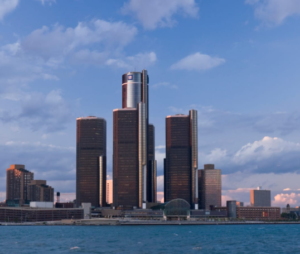MIDWEST: MIDWAY, 2020
East North Central: IL, OH, WI, IN, MI
Illinois
Despite many of the extenuating issues in the state of Illinois and the relative problems controlling COVID, Illinois has had a resurgent housing market in 2020, and that forecast is predicted to continue into 2021. The median state-wide sales price rose ~16.5% from October 2019 to October 2020 to ~$233K (Illinois REALTORS). Extending out from Chicago itself, in the nine surrounding counties, home sales are up ~34% annually. Interestingly, the University of Illinois’ Regional Economics Applications Lab reported that most moves occurred in the same county and/or town (University of Illinois’ Regional Economics Applications Lab). In any event, robust growth is still on target for Illinois housing, at least to start 2021; with the administration of the vaccine, however, demand might decrease, making folks remember the same debt and tax issues that have plagued the state for years.
Ohio
Already strong markets in northeastern Ohio have seen a further boost in 2020. Columbus home prices are up ~17% annually (Columbus Business First). In Summit County, property values have climbed to a value higher than that before the Great Recession (Akron Beacon Journal). Homes lasted a mere 19 days on the market, and for 100.3% of the asking price (Columbus Dispatch). With the height of the pandemic as the winter months approach, it is likely that demand will continue well into 2021.
Wisconsin
Wisconsin remains on fire, yet still affordable when reviewed against the rest of the country. Even though the median sales price increased from $12K year over year to $130K, that still remains well below the national average (Wisconsin Realtors Association). Supply is limited in the $200K-$400K range (Mortgage Professional America), and bidding wars are starting to crop up. For the demand, that presents an interesting opportunity to out of state investors, especially when compared with higher-cost options in other states. A bidder from NY might be able to remain more competitive in the market than an in-state resident. As such, with a movement to the suburbs of Milwaukee on the rise, this would create a market for individuals looking to cash in on rental investments.
Indiana
Similar to Wisconsin, Indiana remains affordable- the #1 most affordable place to own real estate per Forbes (Forbes) with a median home price of $170K, even if that represents a 9.7% year-over-year (Zillow). Combined with a shortage of new construction, quality homes are hard to find for the market with the highest job growth in the Midwest (Norada Real Estate). With an inflow from neighboring Illinois, Indiana presents an opportunity for would-be investors to be able to buy cheaply, renovate, and move on to the next project quickly as interest rates are now at historic lows. However, opportunity windows will likely only be within the next year to make the money bang for the buck, as the state legislature is tackling the housing shortage in the 2021 agenda.
 Michigan
Michigan
Michigan is seeing a 10% increase in the average value of a home (Michigan Association of Realtors), but it is not just mid-level housing that is seeing a market surge. Interestingly, despite economic concerns surrounding the pandemic, home builders in the state are seeing record demand, with some companies booked two years out, and no longer taking on additional clients (Home Builders Association of Northern Michigan). In-resort areas of northwest Michigan, prices increased ~$80K over the course of a year, from August 2019 to August 2020; in that same month, 51 more homes were sold than the same month the year previous (The Detroit News). Homes in this tier typically range from $400K – $900K, even with lumber costs up ~170% since April 2020 and costs are up ~$16K for a new build.
West North Central: IA, KS, MO, NE
Iowa
Marketwatch has Des Moines, Iowa pegged as one of the go-to markets in a post-pandemic world (Marketwatch). As discussed by the National Association of Realtors, there has been a trend away from the high-density, high-cost coasts and into the Midwest, fueled by work-from-home culture and the pandemic (National Association of Realtors), which has made up for the lack of diversity in the local economies. However, while there are always opportunities, it remains to be seen if cities like Des Moines will remain a staple long-term: higher interest rates may drive away would-be buyers from ravaged cities, but will cities in Iowa have the same draw as other, cheaper Midwest locales? Time will tell.
Kansas
While demand is strong in Kansas, the economy will almost certainly be impacted by a recession, thereby impacting the home market. There will be high demand, but low inventory in most of the major metros, including Kansas City, Topeka, Lawrence, Manhattan, and Wichita (Wichita State University). However, this may be offset by a projected ~21% increase in home build permits in the coming year. Even with the additional inventory, however, prices are expected to rise by about ~5% in 2021.
Nebraska
Omaha has taken Cincinnati’s title as the fastest-growing real estate market to close out 2020 (Cincinnati Business Journal). Interestingly, where other metros in the country are being driven by people moving out of attached housing, Omaha is one of the only metros where condo sales are outpacing single-family home sales by ~6% (Redfin). The city has also largely been spared the economic impacts of the COVID crisis as compared to the rest of the country (largely because many of the “Silicon Prairie” jobs have easily transitioned to remote work), creating great stability (Senior Housing News).
Missouri
The last year has brought a number of surprises to the real estate industry, but one of the most surprising is that three of the 15 hottest markets are located in Missouri- two neighborhoods in Kansas City, MO, and Kinloch, MO. Forbes reports that with the combination of suburban homes in high-demand with COVID and the affordability gap of coastal states, the midwestern cities are attracting millennials looking to get into the market (Forbes). With “affordable family-sized houses, good job markets, as well as many of the same big-city attractions like restaurants, bars, sports teams, and cultural institutions,” these cities are becoming havens for tech startups and so-called “smart” manufacturing businesses, bringing more white-collar jobs to these areas than have been present historically. As such, these opportunities are more sustainable, meaning Missouri will likely continue to be a strong market in the long-term.


